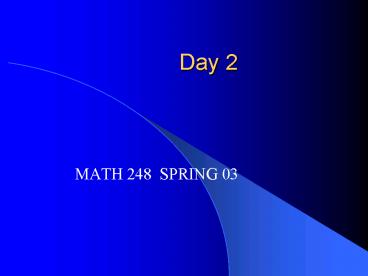Day 2 - PowerPoint PPT Presentation
1 / 30
Title:
Day 2
Description:
Fetches from memory decodes instructions tells system execute instructions. 3 Address Registers ... Decode instruction. Execute instruction. Increment counter ... – PowerPoint PPT presentation
Number of Views:36
Avg rating:3.0/5.0
Title: Day 2
1
Day 2
- MATH 248 SPRING 03
2
What a Computer Does
- It can manipulate and organize information.
- Oh yeah like what?
- Move it
- Store it
- Retrieve it
- Perform simple mathematical and logical
operations on it.
3
What a Computer Does
- A computer must be programmed to do anything!
- A computer manipulates information based on its
program!
4
What a Computer Does
- It can input information from the outside world.
- It can output information to the outside world.
- It can make simple yes/no decisions based on the
information it has been given
5
THATS IT!!!!!
6
Vocabulary
- CPU
- Central Processing Unit
- BRAINS
- Housed in microprocessor
7
CPU Performs
- Simple Logic
- Arithmetic
- Compare , lt, or gt
- Jump, Skip
- Stores and Retrieves Insructions
- Stores and Retrieves Data
8
Standard CPU Architecture
- 1 ALU
- arith. logic unit
- Circuits perform arith. logic
- 2 Control Unit
- Traffic Controller
- Fetches from memory decodes instructions tells
system execute instructions - 3 Address Registers
- Store addresses
9
Basic Logic of a 4 bit ALU
10
The Wired Version
11
Standard CPU Architecture
- 4 Accumulator
- Register(s)
- Accumulates bits swapped in and out of the ALU.
- 5 CONH
- Registers
- Store exceptional conditions within the CPU
- 6 Shifter
- Stores, carries and rotates results
12
Standard CPU Architecture
- 7 P Z
- Register(s)
- Let the ALU manipulate data at high speed.
- 8 P Counter
- Register
- Contains the address of the next instruction to
be fetched and executed. The program counter is
then incremented and the next processing cycle
begins. - 9 S Pointer
- Register
- Keeps track of the STACK.
13
Standard CPU Architecture
- The Processing Cycle (simplified)
- Fetch the next instruction
- Decode instruction
- Execute instruction
- Increment counter
- 10 STACK
- Register(s)
- The Stack is not part of the CPU it is part of
memory. - The pull operation results in a transfer of the
word at the top of the stack into the
accumulator. - The push operation puts a word on the stack. The
final accumulator contents are deposited on top
of the stack. - The Stack Pointer keeps track of whats next on
the stack. First word at the bottom.
14
BASIC COMPUTER
15
More Detailed CPU
Special Registers
- CU Instruction Decoder
- 3-State is a gate that can send a 1, 0, or
terminate - Again Program Counter is a gate which can also
- A) increment by 1
- B) reset to 0
16
PRIMARYMEMORY
- RAM
- Stores instructions and data of the executed
program 64-256 Mb - LOST!
- ROM
- Read Only Memory Important Memory400-500 Kb
- SAVED
- CPU Registers
- Special High Speed Memory Locations holds
information while program is executed - LOST!
17
More Detailed Computer
18
STORAGE
- bit? 1 or 0
- byte?23 bits
- Kb?210 bytes 213 bits
- Mb?210Kb 220 bytes 223 bits
- Gb?210Mb 220 Kb 230 bytes 233 bits
- Tb?210Gb 220 Mb 240 bytes 243 bits
19
More VOCABULARY
- WORD- of bits in a CPU register
- EX word length of 32 bits or 4 bytes
- word 010001000011100010000101010110111
- ADDRESS- is a number attached to each word or
byte so it can be accessed - OPCODE- basic machine operations , , load
, store,.
20
More VOCABULARY
- OPERAND-the item (word) to be operated on
- MACHINE INSRUCTIONS- are words
- part 1 represent an opcode
- part 2 represent address of operand
21
NOWLook at Example
- FORTRAN 90
- Page 4
22
More VOCABULARY
- ASSEMBLY LANGUAGE set of abbreviated text names
for opcodes and operands - ASSEMBLER changes assembly language into machine
language
23
NOWLook at Example
- FORTRAN 90
- Page 4
24
More VOCABULARY
- HIGH LEVEL LANGUAGE program source code written
in a language similar to our own. - COMPILER converts high level code into machine
code. - SYNTAX rules for a language . These RULES MUST
be OBEYED!!!
25
4 Steps to Programming
- 1) THE PROBLEM
- What is the GOAL?
- The Inputs ? The
Outputs ? The Givens
To Prove
26
4 Steps to Programming
- 2) (i) DATA ORGANIZATION
- What are the Variables ?
- What are the units of Variables ?
- What symbols represent the Variables?
- (ii) ALGORITHM
- How to solve the Problem ?
- Flow Charts and Psuedocode
- Basic Outline of the proof
27
4 Steps to Programming
- 3) PROGRAM CODING
- Developing Program for Algorithm
- Coding Program
- rough draft of proof
- writing proper proof
28
4 Steps to Programming
- 4) EXECUTION TESTING
- Compile and Run Program
- Test Algorithm and Program with specific input
values where the output values are already known.
- Hand proof to teacher/editor and Get back
graded proof and cry.
29
ERRORS
- A) Compile Time
- B) Run Time
- C) Logic
30
NOWLook at Basics of a Program
- FORTRAN 90
- Section 2.5































